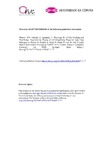Analysis and Knowledge Discovery by Means of Self-Organizing Maps for Gaia Data Releases

Use this link to cite
http://hdl.handle.net/2183/35383Collections
- Investigación (FIC) [1678]
Metadata
Show full item recordTitle
Analysis and Knowledge Discovery by Means of Self-Organizing Maps for Gaia Data ReleasesDate
2016Citation
Álvarez, M.A., Dafonte, C., Garabato, D., Manteiga, M. (2016). Analysis and Knowledge Discovery by Means of Self-Organizing Maps for Gaia Data Releases. In: Hirose, A., Ozawa, S., Doya, K., Ikeda, K., Lee, M., Liu, D. (eds) Neural Information Processing. ICONIP 2016. Lecture Notes in Computer Science(), vol 9950. Springer, Cham. https://doi.org/10.1007/978-3-319-46681-1_17
Is version of
http://dx.doi.org/10.1007/978-3-319-46681-1_17
Abstract
[Abstract]: A billion stars: this is the approximate amount of visible objects estimated to be observed by the Gaia satellite, representing roughly 1 % of the objects in the Galaxy. It constitutes the biggest amount of data gathered to date: by the end of the mission, the data archive will exceed 1 Petabyte. Now, in order to process this data, the Gaia mission conceived the Data Processing and Analysis Consortium, which will apply data mining techniques such as Self-Organizing Maps. This paper shows a useful technique for source clustering, focusing on the development of an advanced visualization tool based on this technique.
Keywords
Gaia mission
European Space Agency
Data mining
Artificial intelligence
Self-Organizing Maps visualizations
European Space Agency
Data mining
Artificial intelligence
Self-Organizing Maps visualizations
Description
This version of the article has been accepted for publication, after peer review and is subject to Springer Nature’s AM terms of use, but is not the Version of Record and does not reflect post-acceptance improvements, or any corrections. The Version of Record is available online at:
http://dx.doi.org/10.1007/978-3-319-46681-1_17 Versión final aceptada de: Álvarez, M.A., Dafonte, C., Garabato, D., Manteiga, M. (2016). Analysis and Knowledge Discovery by Means of Self-Organizing Maps for Gaia Data Releases. In: Hirose, A., Ozawa, S., Doya, K., Ikeda, K., Lee, M., Liu, D. (eds) Neural Information Processing. ICONIP 2016. Lecture Notes in Computer Science(), vol 9950. Springer, Cham. https://doi.org/10.1007/978-3-319-46681-1_17
Editor version
Rights
© Springer International Publishing AG 2016





